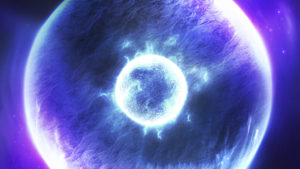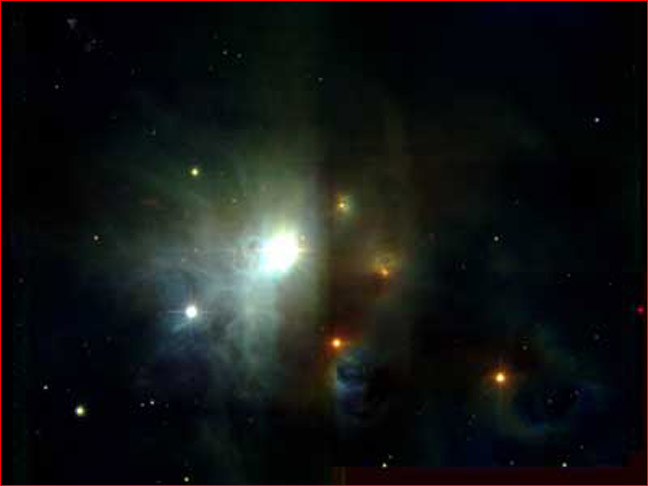


|
Mar 04, 2005 Popular ideas about star and planet formation have received a jolt from a recent peek into the womb of a newly forming star. The shock came from the European Space Agency's XMM-Newton X-ray observatory as it peered into a star-forming region called R Corona Australis, about 500 light-years from Earth. The astronomers who investigated the region were well schooled in the standard “nebular hypothesis” of star and planet formation. The theory holds that stars are born in the “gravitational collapse” of vast precursor clouds over great spans of time. Based on their model, astronomers had assumed that the cloud was “between 10,000 to 100,000 years into the process of gathering itself together”. Its temperature was estimated at 400 degrees below zero Fahrenheit (minus 240 Celsius). Traditional theory says that millions of years will pass before the cloud has collapsed sufficiently to “ignite the nuclear fusion” of a new star. Investigators had not anticipated anything comparable to the events they observed. Extremely high energies were at work, strong enough to produce X-rays—something that could never occur in an inactive and diffuse cloud in space: “ The detection of X-rays from the cold stellar precursor surprised astronomers,” states a report by SPACE.com. “The detection of X-rays this early indicates that gravity alone is not the only force shaping young stars," said Kenji Hamaguchi, a NASA-funded researcher at the Goddard Space Flight Center. The gravity-driven universe is, of course, the bedrock of popular cosmology. Now it has failed another test. “The observations reveal that matter is falling toward the core 10 times faster than gravity could account for,” the report states. According to Michael Corcoran of NASA Goddard, a co-author on the report, "The X-ray emission shows that forces appear to be accelerating matter to high speeds, heating regions of this cold gas cloud to 100 million degrees Fahrenheit". By comparison, the superheated corona of the Sun measures at about 2 million degrees Fahrenheit. What is happening inside R Corona Australis? The investigators concluded that “some previously unrealized energetic process, likely related to magnetic fields, is superheating parts of the cloud, nudging it to become a star”. We’ve seen this many times before: a new discovery evokes statements of surprise, and magnetic fields are mysteriously factored in to save appearances—but with no mention of the electric currents that create magnetic fields. How does this happen? It happens because electricity is re-defining the physical universe, while conventional astronomers hold steadfastly to an electrically neutral, gravity-only universe. No official acknowledgement of this crisis has ever been issued by mainstream institutions. Yet without electric neutrality across the plasma of interstellar and intergalactic space, popular cosmology loses its foundation. Not only the gravity-based models, but everything conjured through the magic of gravitational mathematics (from dark matter and dark energy to black holes) will evaporate. There is a simple, readily observed, and easily testable physical process that accounts for the discoveries in R Corona Australis. Those who have studied plasma and electricity in the laboratory discuss the dynamic all the time. The work began with the Swedish experimental researcher Kristian Birkeland, and culminated in the pioneering life’s work of Nobel Laureate Hannes Alfvén, the father of plasma science. Alfvén, the researchers that worked with him, and such independent researchers today as Australian physicist Wallace Thornhill and retired professor of electrical engineering Donald Scott have offered numerous insights on the role of electricity in space. And their models have demonstrated exceptional predictive ability. Astrophysicists know that such clouds are slightly ionized. However, in the Electric Universe they are not everywhere charge neutral. As a result electric fields and currents exist within the cloud. These electric currents take the form of parallel filaments in twisted pairs, behaving like cosmic power transmission lines. The electromagnetic force between the filaments is the strongest long-range force in the universe since it falls off linearly with distance rather than with the square of the distance as does gravity. That is why matter is falling into core of the cloud “10 times faster than gravity could account for". Plasma cosmologists also understand that electric currents heat and accelerate gas to high speeds, generating intense magnetic fields. And in electromagnetic "z-pinches" along these current filaments, plasma instabilities generate copious x-rays! The more we learn about the cosmos the less it looks like the picture still taught in school. But without vigilance old theories become an ideology and persist far beyond their usefulness. |
||
|
Copyright 2005: thunderbolts.info |
||